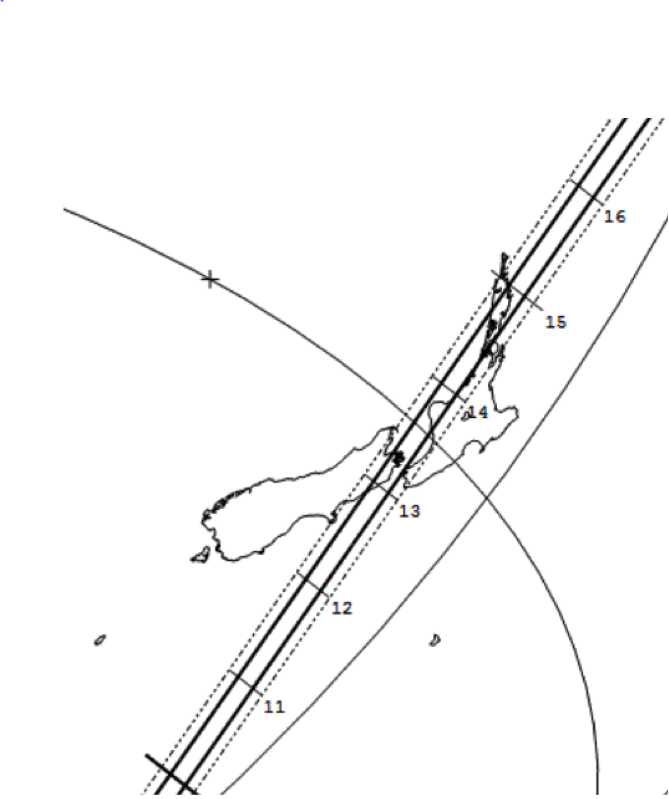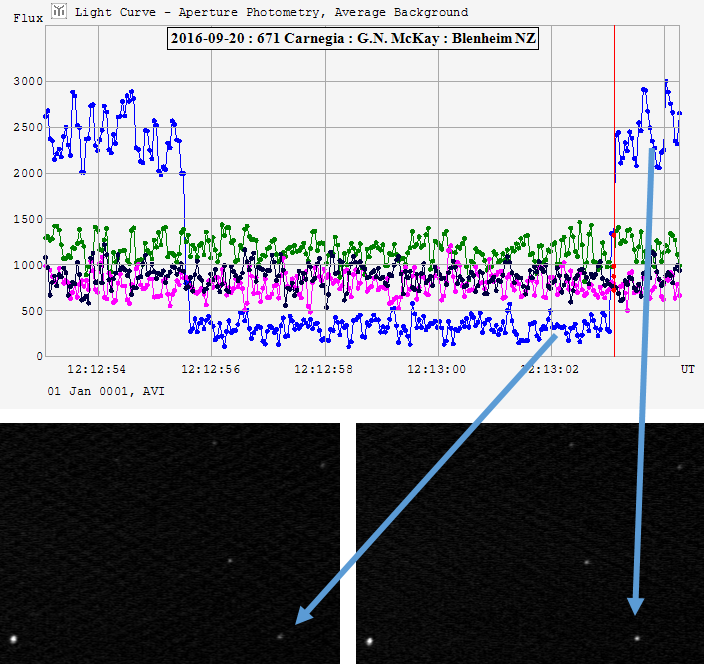IoW_20161021 - Gaia
Image of the Week |
|||
First post-Gaia asteroid occultation success: A feedback from amateur astronomy |
|||
 |
|||
|
Figure 1. The borders of the predicted occultation path (solid diagonal lines) and their uncertainty margins (dashed lines), superposed on the outlines of New Zealand's main islands. The labelled tick marks are the predicted central occultation times in minutes, counting from September 20, 12:00 UTC. The two smooth arcs are geographic coordinate lines indicating -40 degrees of latitude and +/-180 degrees of longitude, respectively. |
|||
|
Less than one week after the publication of Gaia Data Release 1 (Gaia DR1), New Zealand amateur astronomer Graeme McKay successfully observed the occultation of a star by an asteroid. Just three weeks earlier, the predicted occultation path lay more than 4 path widths — or hundreds of kilometers — from his location at Blenheim, New Zealand. On Sep 20, the 60-kilometer minor planet (671) Carnegia was due to pass in front of a 10th-magnitude star with the romantic-sounding designation TYC 6888-01416-1. Predictive calculations by the International Occultation Timing Association (IOTA) said the event should occur along a narrow strip (known as occultation path) of the remote watery solitudes of the Pacific and South Polar Ocean. McKay would probably not have tried any observation that night. But then two things happened and changed this situation, as reported by IOTA’s Australian activist Dave Herald in a IOTA Yahoo group:
Preston’s September 16 calculation gave a revised occultation path running right over New Zealand’s main islands. It is shown in Fig. 1 (taken from the public prediction page). Accordingly, McKay went to his home observatory in time for the event, started his “C11” telescope (28cm aperture) and “Watec-120N+” video camera and then waited to see what would happen. The star’s brightness recording derived from the resulting video is shown in Fig. 2. A very clear and pretty occultation light curve was the observer’s reward. “I feel privileged to be the first to report a positive occultation result based on the new Gaia data set.” was Graeme McKay’s comment after the observation. |
|||
 |
|||
|
Figure 2. Top: Successful observation by Graeme McKay of the asteroid Carnegia occulting a star. The blue curve shows the brightness of the target star as function of time. The onset and end of the 8-seconds occultation are clearly marked by the two sudden jumps of the blue curve. The other three curves (pink, black and green) show similar curves for three different unrelated stars which are close by on the sky, and which were thus observed by the video camera along with the target star. Such neighbouring stars are routinely used as checks against possible instrumentation malfunctions and terrestrial clouds which could produce fake brightness drops. Bottom: Two original video frames are shown here, the one to the left shows the star during the occultation, the one to the right is taken just after the re-appearance of the star. |
|||
|
The success means that both the new star position from Gaia and the revised asteroid orbit determination are correct and highly precise. In the future, IOTA’s work on the improvement of asteroid orbits and the determination of diameters and shapes of asteroids will become much more efficient: The missed opportunities — observers sitting on their telescopes in vain — due to imprecise occultation path predictions will become much less frequent. IOTA is a world-wide amateur-professional organisation devoted to the observation and scientific usage of star occultations by planets, asteroids and the Moon. |
|||
|
Credits: Graeme McKay, Steve Preston, Ulrich Bastian [Published: 21/10/2016] |
|||
- Removed a total of (18) style text-align:center;
- Removed a total of (8) style text-align:justify;
- Removed a total of (1) border attribute.
- Removed a total of (1) cellpadding attribute.
- Removed a total of (1) cellspacing attribute.
Image of the Week Archive
- Removed a total of (1) border attribute.
- Removed a total of (1) cellpadding attribute.
- Removed a total of (1) cellspacing attribute.








































 Sign in
Sign in
 Science & Technology
Science & Technology